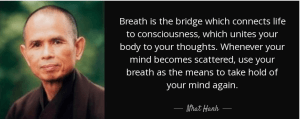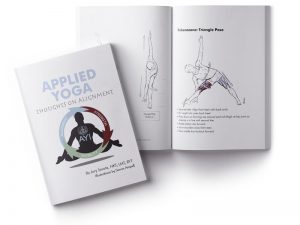About 4 years ago I was having a conversation with a friend who told me that the Navy teaches their soldiers to breathe in and out of their noses while they’re training. At first thought, I said, “That’s a mistake”, but as I thought about it more, I realized I couldn’t be more wrong.
 My initial thought came because in tennis we are taught to exhale out our mouths when we hit the ball. If you ever watched Andy Roddick play, especially in his last 3 years, you can audibly hear his exhalation when he makes contact with the ball. This exhalation brings a
My initial thought came because in tennis we are taught to exhale out our mouths when we hit the ball. If you ever watched Andy Roddick play, especially in his last 3 years, you can audibly hear his exhalation when he makes contact with the ball. This exhalation brings a
presence and a force to the drive we get out of our strokes. But inhalation and exhalation through our mouths is not the way to calm our minds and generate endurance.
The moment we “lose” our breath, we start breathing in and out of our mouths and a sympathetic fight or flight response is induced. In athletics, this happens quite early for some people and later for others. Our endurance for our sport immediately decreases when we breathe this way and immediately increases when we focus on the inhale and exhale through our nostrils. The good news, as the Navy demonstrates, is that this can be trained.
The Yogis taught thousands of years ago that the way we breathe has a direct correlation to the way we think. A short and hyper breath will create a more panicked and anxious state of mind whereas a slower, deeper, and more full breath will create a state of calm and tranquility. The Yogi’s studied this so intensely they created a system of breath work (pranayama) to not only work with, but also induce certain states of consciousness. For the Yogi, breath awareness and control is the gateway to the higher stages of consciousness and the higher stages of the yogic path.
 The practices of pranayama involve certain breath techniques and holds, all in and out of the nose. There are two pranayamas that involve breathing in through the mouth and out through the nose, but according to BKS Iyengar, author of Light on Pranayama and one of the foremost yoga teacher’s of our era, these pranayamas are outdated and he did not put much attention to them.
The practices of pranayama involve certain breath techniques and holds, all in and out of the nose. There are two pranayamas that involve breathing in through the mouth and out through the nose, but according to BKS Iyengar, author of Light on Pranayama and one of the foremost yoga teacher’s of our era, these pranayamas are outdated and he did not put much attention to them.
The mind calms when when we breathe out our nose. There is even a Tibetan meditation technique that gives no concern to the inhalation but instead aims all the attention on the nasal exhalation. If you try this for only 5 minutes, you will see the state of calm that quickly gets generated.
If you ask any higher level athlete, they will tell you that performance is somewhere around 20% physical and 80% mental. When an athlete can use their breath to calm their mind, they immediately become more centered, present and confident with the job at hand. In many ways, the focus on the breath becomes the athlete’s secret to success.
Even just last week, I was playing tennis with a new friend. It was 90 degrees outside which means on the court it is at least 100. He and I had only hit once before and as we began to hit on this day I quickly realized that he was not only better than me, he was in better shape. 15 minutes into the match I was huffing and puffing, not able to catch my breath and breathing in and out of my mouth. My cells were tingling, my mind was racing and I wasn’t sure if I was going to make it.
Then…..something else kicked in.
I remembered my Yogic training. I started focusing on breathing in and out of my nose. The fight or flight response I was having disappeared. I caught my breath. The heat no longer bothered me and the ball I was hitting got crisp. I stopped making so many errors and started hitting winner after winner. I won the match in less than an hour and felt awake and energized at the end. My opponent didn’t know what happened and commented on how well I played.
To be able to apply a conscious breath to our athletic activity, we must first be able to apply a conscious breath to our meditation practices and every day lives. If we can not focus on and watch our breath while we are walking or eating, how are we going to be able to in the heat of battle?
 One simple technique to begin your training is to lie on your back and take a supported Savasana (corpse pose), like the woman on the right. It is important to have the chest slightly lifted and the neck supported. The chin should be lower than the forehead and you should feel very comfortable. Begin by simply watching the breath. Don’t try to control it or do anything special with it. The key to gaining control over your breathing patterns is first learning to relax. When we try to force or control the breath before the nerves are ready, we wind up creating tension and anxiety as opposed to ease and relaxation. Take 5 minutes to relax and simply watch the breath as it is. You may fall asleep or at some point, the breath may actually deepen. Both are ok and arise based on certain conditions and mental factors. Just allow whatever is taking place to take place. If you practice this for only 5 minutes a day, every day for a week, I guarantee there will be a different awareness of your breath in your everyday life.
One simple technique to begin your training is to lie on your back and take a supported Savasana (corpse pose), like the woman on the right. It is important to have the chest slightly lifted and the neck supported. The chin should be lower than the forehead and you should feel very comfortable. Begin by simply watching the breath. Don’t try to control it or do anything special with it. The key to gaining control over your breathing patterns is first learning to relax. When we try to force or control the breath before the nerves are ready, we wind up creating tension and anxiety as opposed to ease and relaxation. Take 5 minutes to relax and simply watch the breath as it is. You may fall asleep or at some point, the breath may actually deepen. Both are ok and arise based on certain conditions and mental factors. Just allow whatever is taking place to take place. If you practice this for only 5 minutes a day, every day for a week, I guarantee there will be a different awareness of your breath in your everyday life.
In my two upcoming seminars, “Functional Yoga Training” and “NeuroKinetic Yoga”, we will be going over breath work and its many applications in detail. You will learn how to apply conscious awareness of breath, not only to yourselves but also to your clients and patients. This will be an invaluable aid in their mind/body healing.
I hope you will join me, and I hope you will take some time today, and everyday, to allow yourself to bring attention to your breath. The benefits will speak for themselves.


